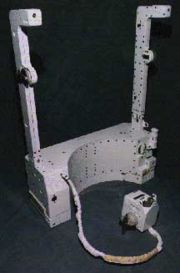
Simplified Aid for EVA Rescue
Encyclopedia

Jet pack
Jet pack, rocket belt, rocket pack, and similar names are various types of devices, usually worn on the back, that are propelled by jets of escaping gases so as to allow a single user to fly....
) used to provide free-flying mobility for a Space Shuttle
Space Shuttle
The Space Shuttle was a manned orbital rocket and spacecraft system operated by NASA on 135 missions from 1981 to 2011. The system combined rocket launch, orbital spacecraft, and re-entry spaceplane with modular add-ons...
or International Space Station
International Space Station
The International Space Station is a habitable, artificial satellite in low Earth orbit. The ISS follows the Salyut, Almaz, Cosmos, Skylab, and Mir space stations, as the 11th space station launched, not including the Genesis I and II prototypes...
(ISS) crewmember during extra-vehicular activity
Extra-vehicular activity
Extra-vehicular activity is work done by an astronaut away from the Earth, and outside of a spacecraft. The term most commonly applies to an EVA made outside a craft orbiting Earth , but also applies to an EVA made on the surface of the Moon...
(EVA). SAFER is a small, simplified version of the Manned Maneuvering Unit
Manned Maneuvering Unit
The Manned Maneuvering Unit is an astronaut propulsion unit which was used by NASA on three space shuttle missions in 1984. The MMU allowed the astronauts to perform untethered EVA spacewalks at a distance from the shuttle. The MMU was used in practice to retrieve a pair of faulty communications...
(MMU) intended for contingency use during spacewalks.
Application
SAFER is designed to be used as a self-rescue device for a separated EVA crewmember in situations when no vehicles can provide rescue capability. SAFER is worn by every ISS crewmember using an Extravehicular Mobility UnitExtravehicular Mobility Unit
The Space Shuttle/International Space Station Extravehicular Mobility Unit is an independent anthropomorphic system that provides environmental protection, mobility, life support, and communications for a Space Shuttle or International Space Station crew member to perform extra-vehicular activity...
. SAFER was developed by the Robotics Division (with its contractor staff) of NASA
NASA
The National Aeronautics and Space Administration is the agency of the United States government that is responsible for the nation's civilian space program and for aeronautics and aerospace research...
at the Johnson Space Center. Prior to ISS, the EVA rescue plan was to maneuver the shuttle orbiter to retrieve the astronaut, but because the massive ISS does not have this kind of maneuver capability, it was decided to give the EVA astronauts the ability to maneuver themselves.
SAFER was first flown on STS-64
STS-64
STS-64 was a Space Shuttle Discovery mission to perform multiple experiment packages. It was launched from Kennedy Space Center, Florida, on 9 September 1994.-Crew:-Mission parameters:*Mass: payload*Perigee: *Apogee:...
where an untethered flight test was performed. SAFER has a mass of approximately 83 lb (38 kg) and can provide a total change in velocity (delta-v
Delta-v
In astrodynamics a Δv or delta-v is a scalar which takes units of speed. It is a measure of the amount of "effort" that is needed to change from one trajectory to another by making an orbital maneuver....
) of at least 10 ft/s (3 m/s). It was also tested during flight STS-92
STS-92
STS-92 was a Space Shuttle mission to the International Space Station flown by Space Shuttle Discovery. STS-92 marked the 100th mission of the Space Shuttle...
when astronauts Wisoff and Lopez-Alegria performed test maneuvers, flying up to 50 feet from the spacecraft.
Complications
The left side latch on the SAFER unit became unlatched during an EVA by astronaut Piers SellersPiers Sellers
Piers John Sellers OBE is a British-born Anglo-American meteorologist and a NASA astronaut. He is a veteran of three space shuttle missions....
on STS-121
STS-121
STS-121 was a space shuttle mission to the International Space Station flown by Space Shuttle Discovery. The main purposes of the mission were to test new safety and repair techniques introduced following the Columbia disaster of February 2003 as well as to deliver supplies, equipment and...
while testing shuttle repair techniques. The latch had been inadvertently bumped and moved to the unlatch position. As a precaution, Mike Fossum tethered it to him and the spacewalk continued. In subsequent spacewalks, the latches were secured with Kapton
Kapton
Kapton is a polyimide film developed by DuPont which can remain stable in a wide range of temperatures, from -273 to +400 °C...
tape, a space-rated form of adhesive tape
Adhesive tape
Adhesive tape is one of many varieties of backing materials coated with an adhesive. Several types of adhesives can be used.-Types:Pressure sensitive tape...
, to prevent the latches from inadvertently opening. A hard cover is being designed for future missions.

